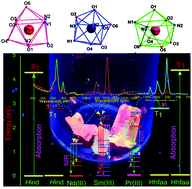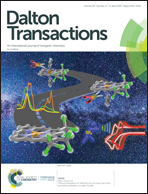Red, orange-red and near-infrared light emitting ternary lanthanide tris β-diketonate complexes with distorted C4v geometrical structures†
Abstract
This paper presents three crystallographically and solution NMR (one- and two-dimensional) characterised ternary Ln(III) complexes, and their photo-physical and opto-electronic properties in the visible and NIR regions. The single crystal X-ray diffraction analysis indicates that the complexes are nona-coordinate with a chemical composition of [Ln(hfaa)3(Hind)3] (hfaa = anion of hexafluoroacetylacetone, Hind = indazole and Ln = Pr, Nd and Sm). The Ln ions, in the complexes, are coordinated to six O-atoms of three hfaa and three N-atoms of three monodentate Hind ligands, making the coordination polyhedra LnO6N3 with distorted monocapped square antiprismatic geometries, low symmetry structures that promote radiative transitions, suggesting efficient energy transfer from the organic ligands to the metal ion. The NMR analysis confirms the nona-coordinate structures and shows the isostructurality of the complexes in solution. The excitation of the complexes at 310 nm led to the characteristic of both visible and near infrared luminescence of the Pr, Nd and Sm complexes. The samarium complex displayed very strong orange-red luminescence. In contrast to the solution, the PMMA doped samples of the complexes showed an enhancement in the emission lifetime and the quantum yield. A triple layered NIR-emitting OLED, fabricated using the Nd-complex as an emitting layer, showed good optical and electrical performances.



 Please wait while we load your content...
Please wait while we load your content...